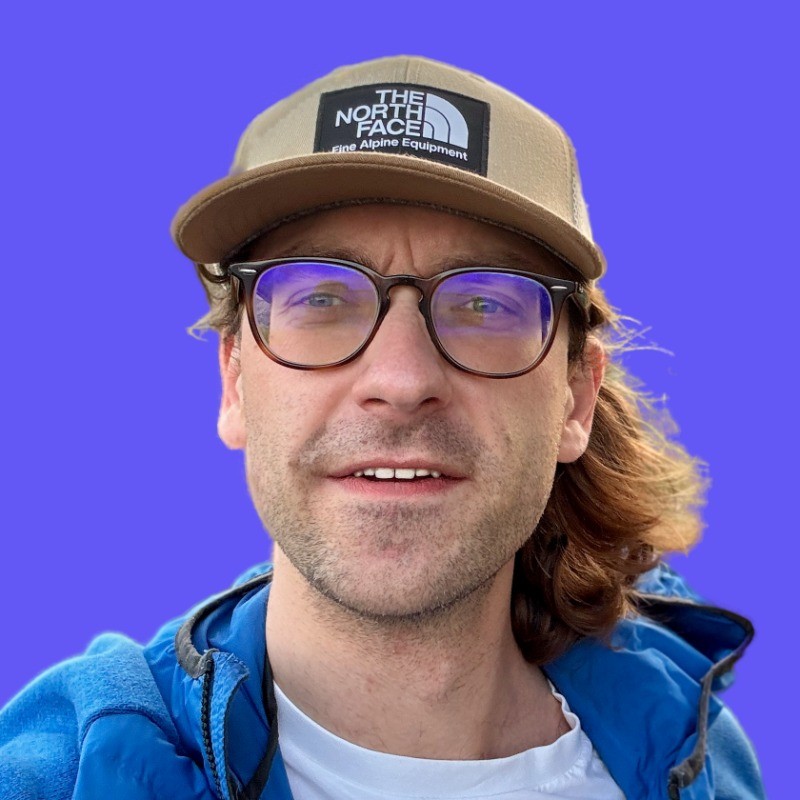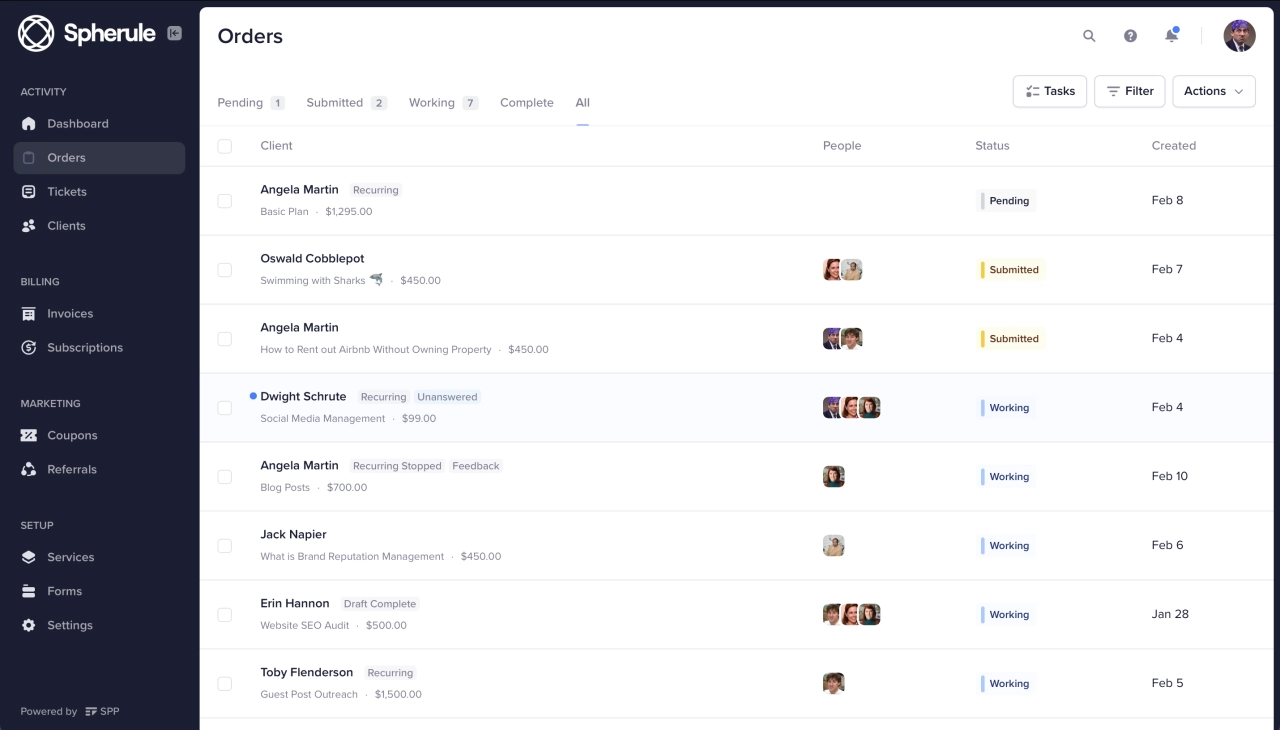- Inconsistent delivery triggers a domino effect—client churn accelerates, top performers leave, and rework consumes 2-5% of annual revenue, creating a catch-22 where you need systems to keep clients but need clients to afford building systems.
- The 3-pillar framework (Standardization, Training, Quality Control) operates as a continuous feedback loop where each pillar strengthens the others—agencies with clear SOPs outperform competitors by 31% and see 25% lower turnover.
- Start with one SOP for your core task execution (4-6 hours to create), which saves 2-3 hours weekly and pays back the time investment within a month—new hires become productive in 2 weeks instead of 2 months.
Still reviewing every deliverable before it goes to clients? You’ve productized your service and your team is growing. But instead of feeling liberated, you feel like a bottleneck.
One client gets exceptional work, while another gets mediocre results. A new team member takes three times as long as a veteran to complete the same task. You spend your days firefighting inconsistencies instead of focusing on growth.
If this sounds familiar, you’ve hit the scaling trap. It’s a sign of success, but it’s also the single biggest threat to your agency’s growth. When quality becomes a lottery, client churn spikes, your brand reputation suffers, and your top performers leave—with nearly half of high-performing employees leaving each year.
The solution isn’t to work harder or hire a “superstar” to fix everything. The solution is to move from being a founder-reliant business to a system-reliant business.
This guide shows you how to build that system. You’ll learn the three-pillar framework for delivering consistent quality at scale—without becoming the bottleneck your business can’t grow past.
Understanding this topic involves several interconnected concepts:
- Client Onboarding
- Client Portal
- Churn Rate
- Intake Form
- Productized Service
- Scope Creep
- Retainer Model
- Project Dashboard
Each of these concepts plays a crucial role in the overall topic.
The scaling trap: why inconsistent delivery kills growth
Before we build the system, let’s be crystal clear about the problem. The very thing that makes productized services so powerful—a defined scope and repeatable process—is also what makes inconsistency so damaging. Clients buy a productized service expecting a predictable, reliable outcome. When they don’t get it, trust erodes instantly.
The impact is measurable and severe:
Client churn accelerates: According to Zendesk’s Benchmark data, more than half of consumers will switch to a competitor after just one bad experience, and 73% will leave after multiple negative interactions. For retainer-based agencies, client turnover above 20% signals serious problems—and likely means another 20-30% of your clients are already at risk.
Top talent walks: 47% of high-performing employees left their companies in 2022, despite being up to 400% more productive than average staff. Your A-players get frustrated carrying the weight for inconsistent colleagues.
New hire costs compound: New hires feel lost without clear processes, and replacing each one costs 16-20% of their annual salary—up to 200% when you factor in lost productivity and training costs.
Margins erode through rework: Redoing work and handling scope creep from unhappy clients eats directly into profits. Rework alone can consume 2-5% of your annual revenue, turning what should be profitable projects into break-even work—or worse.
It’s almost like dominoes falling down as you grow. You sort of get to this point where the first domino gets hit and then all the things that should have been supporting the business start falling down one by one because they’re not supporting each other.
 Dav Nash,
FatJoe
Dav Nash,
FatJoe
These aren’t isolated problems—they’re connected. In Episode 007 of The Agency Engine Room, Dav Nash from Fat Joe described it perfectly:
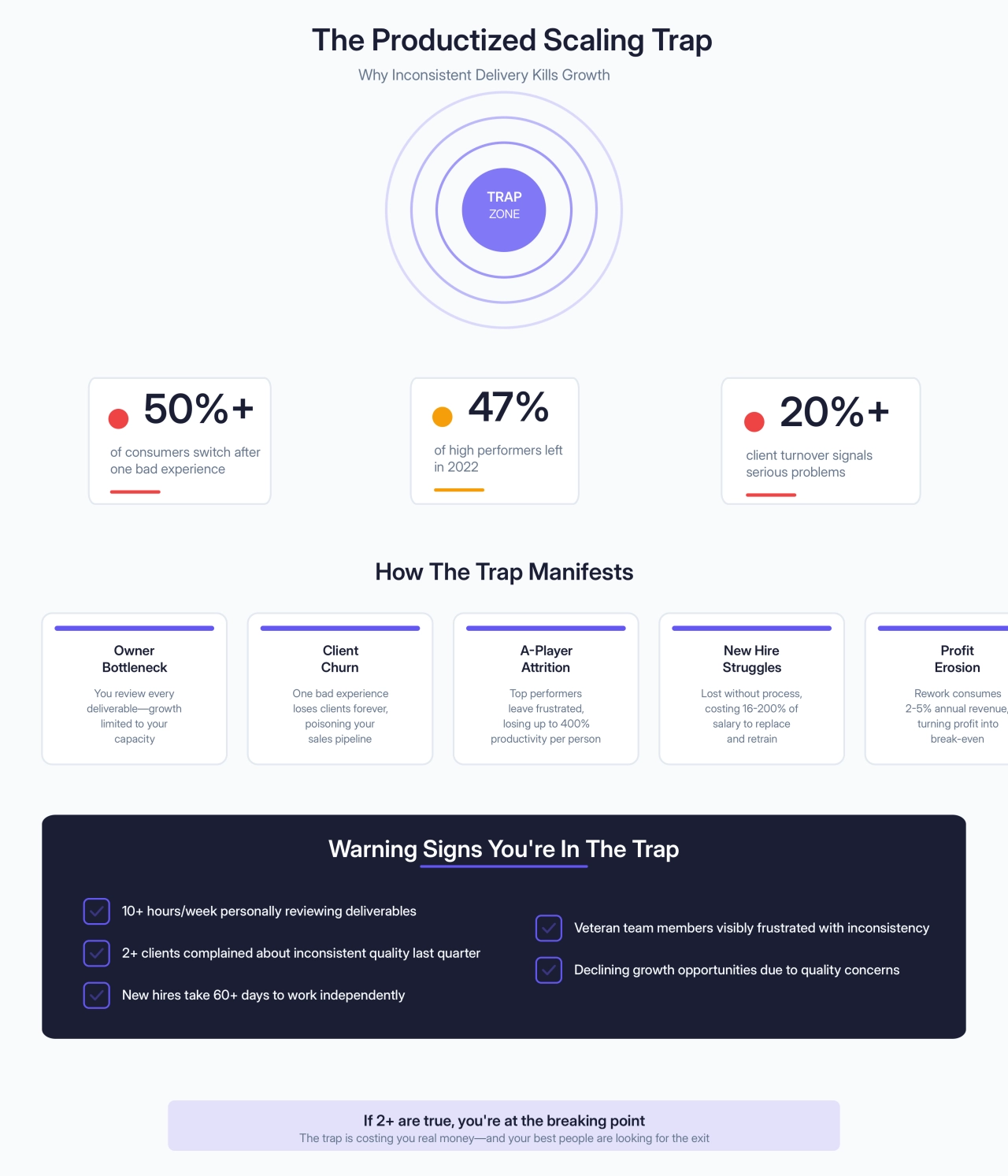
Check the warning signs in the graphic above. If even two apply to your agency, you’re not being paranoid—you’re at the breaking point. The trap is costing you real money, and your best people are already looking at the exit.
You can’t escape this trap by simply wishing for better performance. You need a system.
This is the catch-22 Dav Nash sees constantly: “For us to scale we need more strategic experience, we need more people in, we need better processes, but we’ve just lost a bunch of our clients so now how do we fill that gap? That’s a story that is quite common.” You need systems to keep clients, but you need clients to afford building systems.
But here’s what you’re probably thinking: “I don’t have time to build systems—I’m too busy keeping the ship afloat.”
I get it. You’re reviewing deliverables at 11pm, putting out fires during the day, and wondering when you’re supposed to document processes. Here’s the truth: you’ll never find the time. You have to make it.
The good news? You don’t need to document everything at once. You’re not overhauling your entire operation next Tuesday. Start with one process—the single most chaotic part of your delivery—and build from there. That first SOP takes 4-6 hours. The second takes 3. By your fifth, you can document a process in 90 minutes.
And here’s what happens: that first SOP saves you 2-3 hours per week in rework and reviews. Within a month, you’ve paid back the time investment. Within a quarter, you’ve bought yourself entire days back.
The 3 pillars of scalable service delivery
The power of productized services comes from repetition.
Repetition allows you to perfect your craft without constantly reinventing the wheel. You create more value for future clients by reusing assets. This also means less time spent on each new client.
 Niels Klement,
Perspective
Niels Klement,
Perspective
But repetition only delivers these benefits when you have systems in place. After talking to dozens of agency owners, I’ve found that sustainable scale rests on three interconnected pillars. Think of them not as separate tasks, but as a continuous feedback loop.
The data backs this up: research by McKinsey & Company shows that organizations with clearly defined SOPs outperform their competitors by 31%. Companies with effective SOPs also report 25% lower employee turnover rates and operational efficiency increases of up to 30%.
67% of employees report that their company’s broken processes prevent them from reaching their full potential (Nintex). Your team wants systems—they’re just waiting for you to provide them.
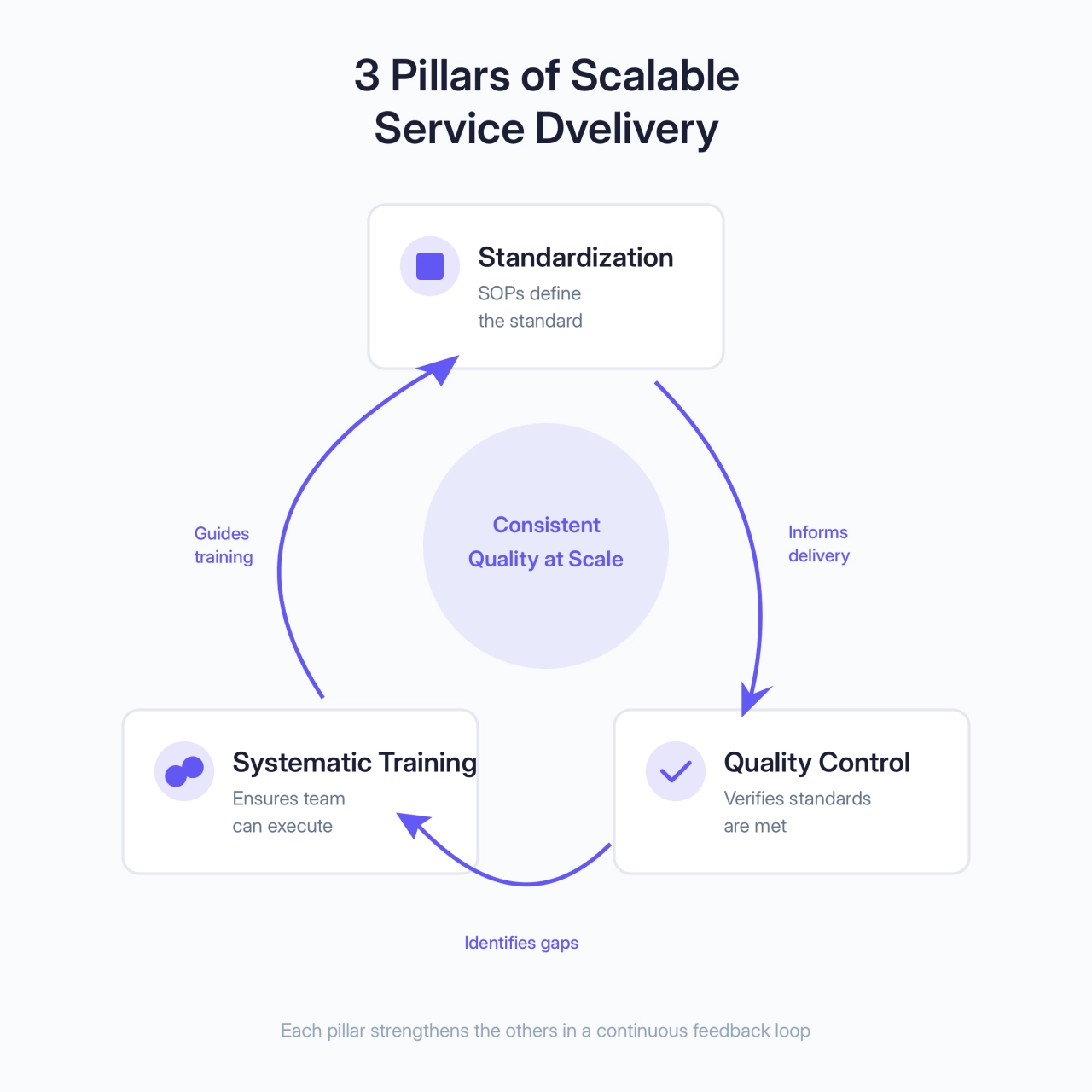
Here’s how these three pillars work together:
Pillar | What It Does | Key Metric | Time to Impact |
|---|---|---|---|
Standardization (SOPs) | Documents the single best way to perform every critical task | Reduction in “how do I do this?” questions | 2-4 weeks |
Systematic Training | Ensures every team member can execute SOPs flawlessly | Time to productivity for new hires | 4-6 weeks |
Quality Control | Verifies work meets standards before reaching clients | Client revision requests | 3-6 weeks |
These aren’t sequential steps—they’re a continuous feedback loop. Your QC process identifies where SOPs need clarification and where training needs reinforcement.
Here’s where it gets powerful: these three pillars create a feedback loop. Your QC process doesn’t just catch errors; it provides data that you feed back to improve your SOPs and identify gaps in your training. It’s a living system that gets smarter over time.
Beyond operational benefits, this framework makes your agency significantly more valuable if you ever want to sell. Buyers pay 2–3x more for agencies with documented systems that don’t depend on the founder.
Standardization: building a repeatable service blueprint with SOPs
When agency owners hear SOPs, they often picture a dusty binder filled with 50-page Word documents that no one ever reads. Let’s get that idea out of our heads.
For a modern productized service, an SOP is an actionable, multi-media guide designed to make excellence the easiest path.
What an SOP looks like for a productized service
A great SOP is a resource your team wants to use because it makes their job easier. It should be:
Checklist-driven: Break down complex processes into simple, sequential steps.
Visual: Use screenshots, annotations, and short screen-recorded videos (using tools like Loom or Scribe) to show, not just tell. A 2-minute video is often better than 500 words of text.
Contextual: Briefly explain why a step is important. This builds understanding and empowers your team to make smart decisions.
Centralized: Stored in a single, searchable place that everyone can access (e.g., Notion, a shared Google Drive, or a dedicated process management tool).
The time that it took for us to find information about the customers, to find the details we needed, like it got reduced drastically at that point.
 Vitor Argos,
MobiLoud
Vitor Argos,
MobiLoud
A step-by-step guide to creating your first actionable SOP
Ready to build one? Don’t try to document your entire business at once. Start with one core process that’s causing friction. Let’s use client onboarding as our example.
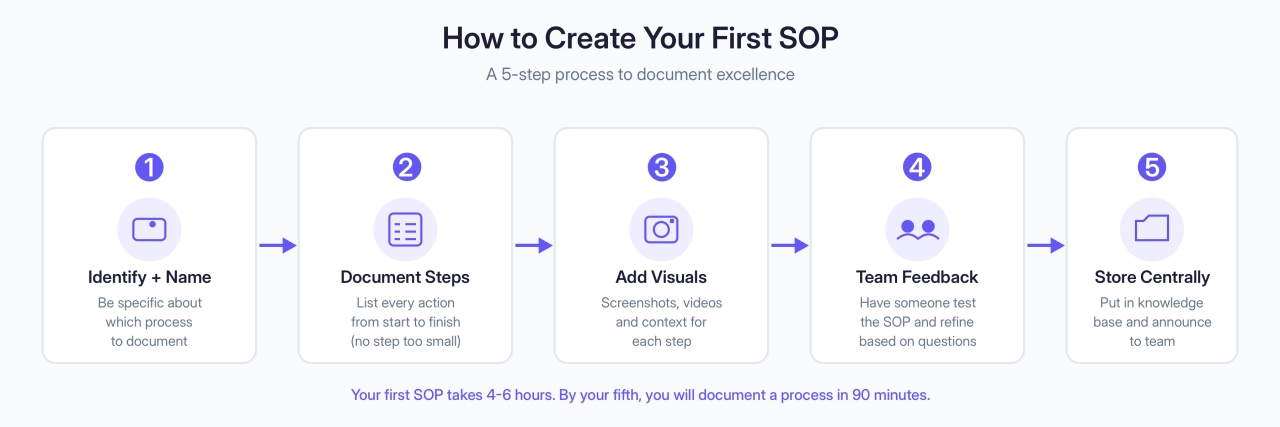
Step 1: Identify and name the process: Be specific. Not “Onboarding,” but “New Client Onboarding for ’Standard SEO Package’.” This clarity is the first step in standardization.
Step 2: Document every single step: Perform the task yourself and record every action. No step is too small. Open a blank document and just list it out.
Receive payment notification from SPP.
Go to client’s order page in SPP to get their intake form details.
Create a new client folder in Google Drive using the naming convention: [Client Name] - [Service].
Copy the ’Project Tracker Template’ into their folder.
Invite the client to their shared Slack channel.
Send the ’Welcome Email Sequence - Day 1’ template.
Step 3: Enhance with visuals and context: Now, transform your raw list into a real SOP.
Add screenshots: Show where to click in SPP to find the intake form.
Record a Loom video: Do a quick screen recording of the entire folder creation and setup process.
Add context: Under the “Send Welcome Email” step, add a note: “Why this is important: This email sets the tone, manages expectations about communication, and confirms we have everything we need to start.”
Step 4: Involve your team and get feedback: Give the draft SOP to a team member and ask them to perform the task using only the SOP. Watch where they get stuck or have questions. Their confusion is your opportunity to clarify the process. This step is non-negotiable—it turns a theoretical document into something your team actually uses.
Step 5: Finalize and store centrally: Once refined, place the SOP in your centralized knowledge base. Announce it to the team and make sure everyone knows where to find it.
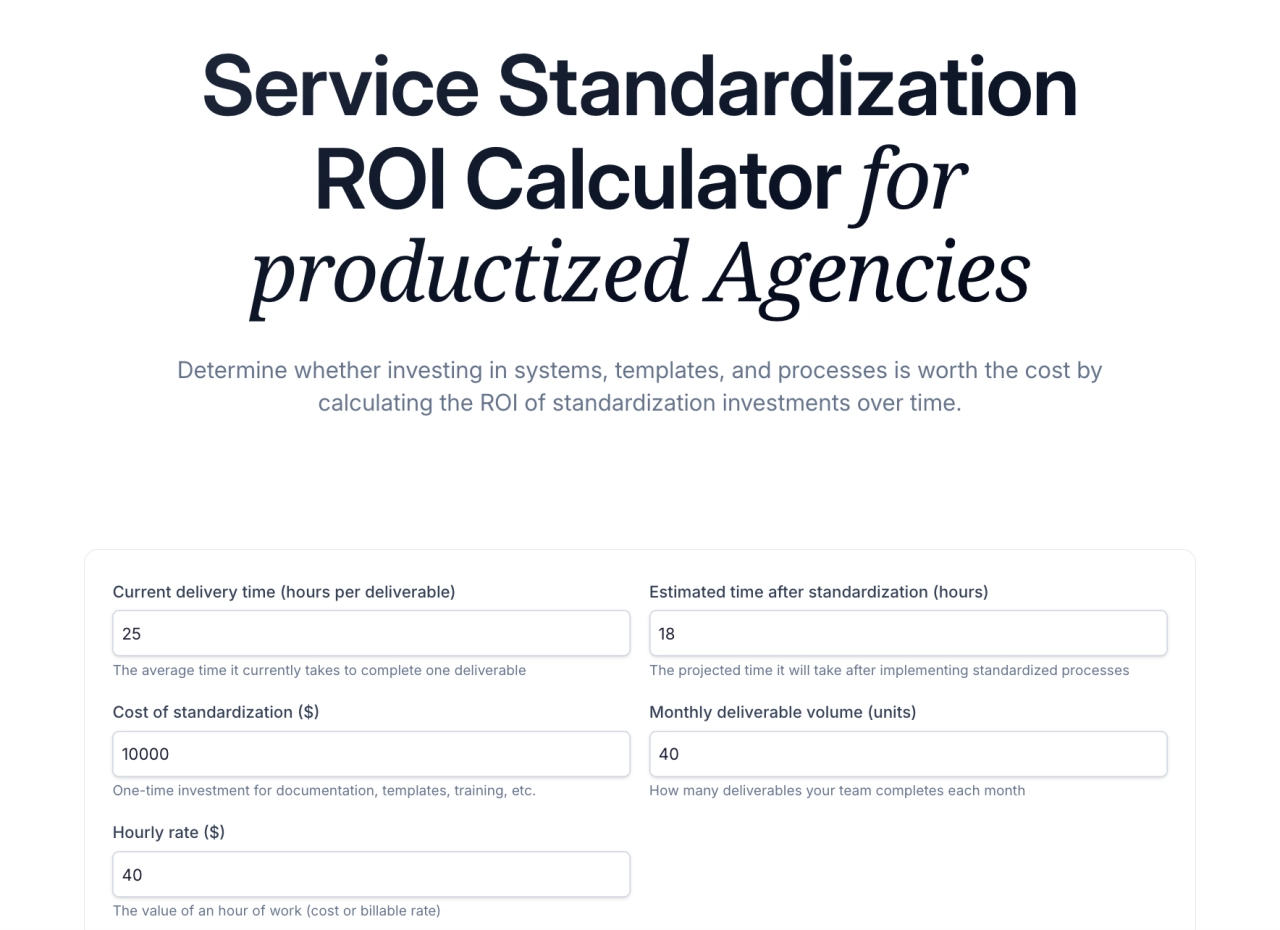
Determine ROI of standardization investments
5 Must-have SOPs for your productized service
Don’t let this list overwhelm you—you don’t need all five to start seeing results. Start with ONE: your core task execution SOP. This is your service’s backbone and delivers the biggest immediate impact. Once that’s working smoothly (2-4 weeks), layer in client onboarding next. The remaining three can wait for quarters 2-3.
Here’s the full foundation, in priority order:
SOP | Priority | Purpose | Implementation Time | Why It Matters |
|---|---|---|---|---|
Core task execution | Start here | Your service’s backbone—the actual work you deliver. Document every step, quality standard, and tool requirement. | 4-6 hours | Biggest immediate impact on consistency and quality. Eliminates “every team member does it differently.” |
Client onboarding | Implement second | Systematize first 72 hours—information collection, expectation setting, project kickoff. | 3-4 hours | Sets relationship tone and prevents mid-project confusion from missing information. |
Client communication protocols | Quarters 2-3 | Define response times, escalation procedures, scope creep handling. | 2-3 hours | Prevents misunderstandings and projects professional organization. |
Project delivery & handoff | Quarters 2-3 | How you present final work, what’s included, file transfer process. | 2-3 hours | Reinforces value and eliminates last-minute questions that derail schedules. |
Handling revisions | Quarters 2-3 | How clients submit feedback, what’s included in revisions, when work becomes new project. | 2-3 hours | Protects team time and prevents endless back-and-forth killing profitability. |
Start with core task execution and get that working smoothly for 2–4 weeks, then layer in client onboarding. The remaining three can wait until you’ve proven the system works.
These SOPs work across all types of productized services—whether you’re running a productized consulting business or a content production agency.
Training: turning SOPs into your team’s second nature
Creating a library of perfect SOPs is pointless if they’re not used. Systematic training is how you turn documentation into daily practice—how you make your processes automatic rather than aspirational. It’s how you embed your processes into your team’s daily habits.
Effective training methods beyond “read this document”
Simply sending a link to a new SOP and saying “read this” is a recipe for failure. Effective training is active, not passive.
The data tells you everything you need to know. According to SHRM research, effective onboarding improves employee retention by 52% and productivity by 60%. Employees who experience exceptional onboarding are 2.6 times more likely to feel satisfied at work, and 69% will stay with the company for at least 3 years.
Yet only 12% of employees believe their organization has a good onboarding process. Even more concerning, 60% of employers fail to set any milestones or goals for new hires (Harvard Business Review). Here’s the opportunity: get your training systems right, and you immediately outperform 88% of your competition.
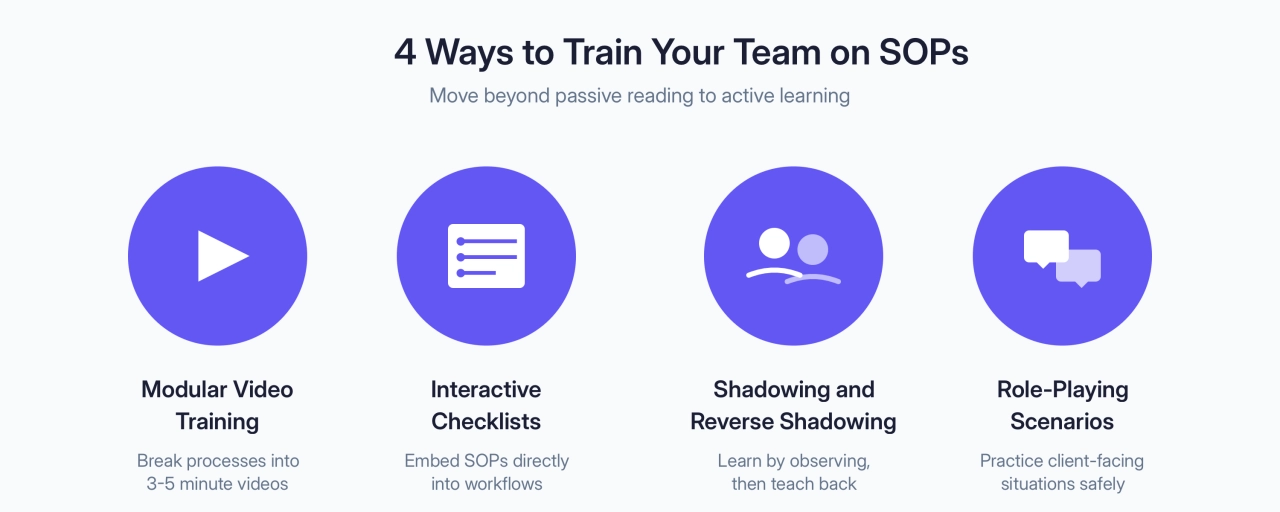
Modular video training: Break down your core process SOPs into a series of short (3-5 minute) videos.
Interactive checklists: For every project, have your team member duplicate a master checklist template that links back to the relevant SOPs for each major stage. This embeds the process directly into their workflow.
Shadowing and reverse shadowing: Have a new hire shadow an experienced team member for their first few projects. Then, reverse the roles: have the experienced team member watch the new hire execute the process, providing real-time feedback.
Role-playing scenarios: For client-facing SOPs (like communication or handling revisions), role-play common scenarios. This builds confidence and ensures your team responds in a way that aligns with your brand values.
How to build a repeatable onboarding system for new hires
Your goal is to get new team members contributing high-quality work as quickly as possible. A standardized onboarding process is key.
Create an Onboarding SOP that outlines the new hire’s first 30 days.
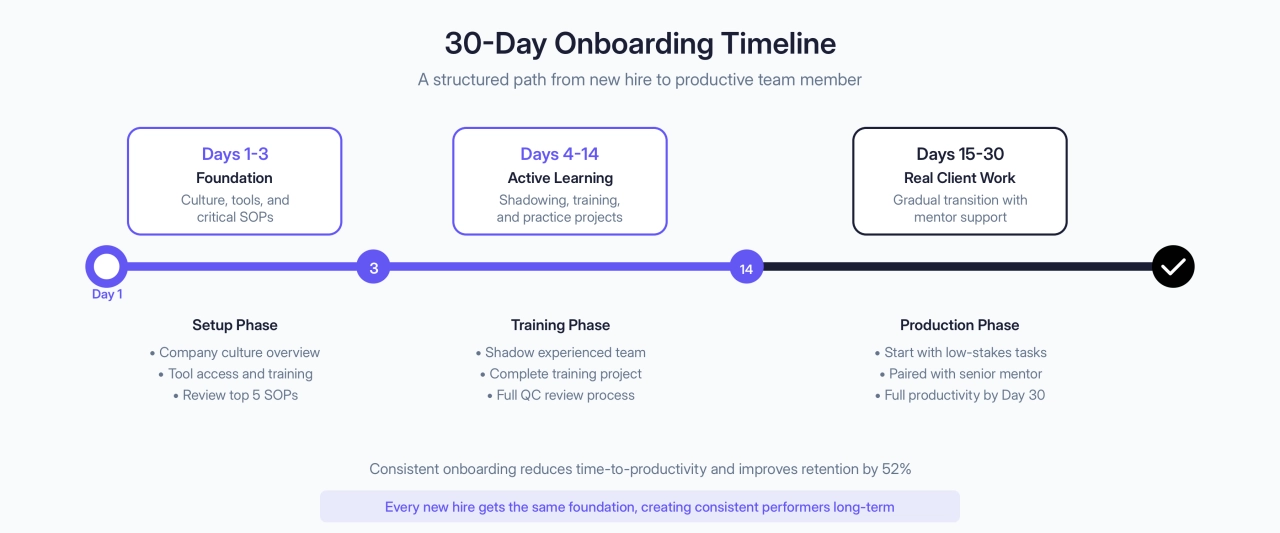
This should include:
Day 1–3: Focus on company culture, tool setup, and a review of the top 5 most critical SOPs.
Day 4–14: A mix of shadowing, training modules, and completing their first “training” project on a dummy client account. This project should be reviewed using your full Quality Control process.
Day 15–30: Gradually transition them to real client work, starting with lower-stakes tasks and pairing them with a senior mentor for support.
This system ensures every hire gets the same foundational knowledge, reducing the burden on you and creating more consistent performers long-term.
Transitioning your existing team to new standards
Your current team members already have their own way of doing things. Here’s how to get them to adopt new SOPs without resistance:
Lead with the “why”: Frame SOPs as protection from scope creep, unclear expectations, and last-minute panic. Your team wants less chaos, not more rules. Start the conversation with: “I’m documenting our best practices so everyone knows exactly what great looks like. This protects your time and reduces stress.”
Involve them in creation: The people doing the work often have the best insights. When you involve team members in documenting SOPs, they adopt standards they helped build. Assign each person one SOP to document for their area of expertise. Their ownership creates buy-in.
Expect 2-3 weeks of friction: Changing habits is hard. Your team might push back initially (“My way works fine”). That’s normal. After a few projects using the new SOP, the benefits become obvious—fewer client revisions, less confusion, faster delivery—and resistance fades.
Address the “my way is better” objection: When a senior team member resists, ask: “Can a new hire replicate your results using your method?” If not, it’s not a scalable process—it’s personal expertise that dies when they leave. SOPs capture their expertise so the whole team can perform at their level.
Once your existing team adopts the first SOP and sees results (fewer revisions, faster delivery, less client confusion), they’ll advocate for documenting more processes. The key is making them co-creators, not just recipients of new rules.
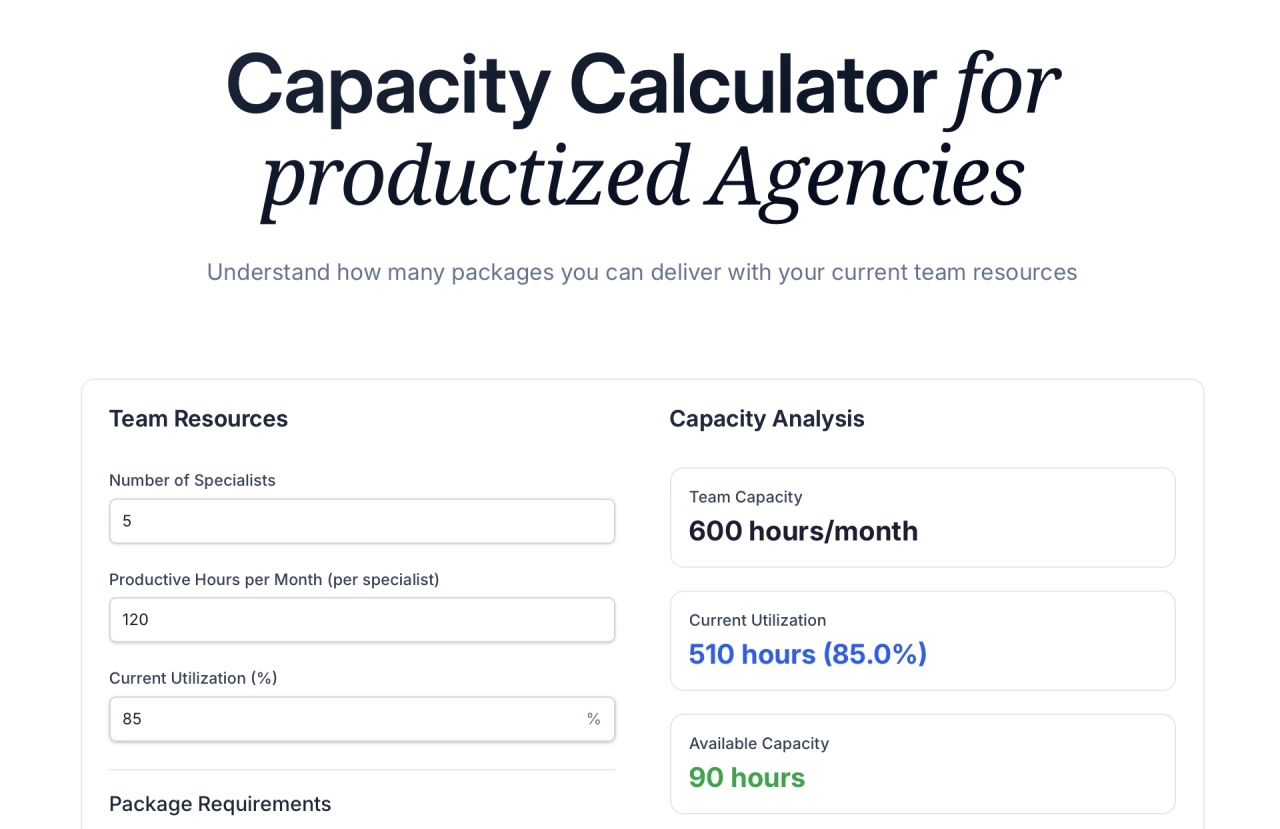
Understand how many packages you can deliver
Quality control: a system to guarantee excellence
Quality control (QC) is the final pillar that holds everything together. Your task is not to catch people making mistakes; you should be systematically ensuring that the output matches the standards defined in your SOPs before the client ever sees it.
The great thing about QC is that it’s your early warning system. It tells you if an SOP is unclear, if a team member needs more training, or if the standard itself needs to be raised.
Designing your quality control workflow
An effective QC process has multiple layers. Depending on the complexity of your service, you might use one or a combination of these:
QC Level | Who Does It | When to Use | Time Investment | What It Catches |
|---|---|---|---|---|
Self-review checklist | Original team member | Every deliverable, always | 5-10 minutes | Simple errors: spelling, formatting, broken links, missed requirements. First line of defense. |
Peer review | Second team member | Standard deliverables | 10-20 minutes | Things the creator missed, inconsistencies with brand standards, quality issues. Spreads knowledge across team. |
Managerial review | Team lead/manager | Critical deliverables or spot-checks | 15-30 minutes | Strategic issues, client relationship concerns, final polish. Should be quick if first two QC steps work. |
Let’s look at one of these productized services examples: a podcast editing service. A QC checklist might include:
Audio levels normalized to -16 LUFS?
All ’ums’ and ’ahs’ removed?
Intro/outro music correctly faded?
Show notes written per client’s template?
Final MP3 file named using correct convention?
This isn’t subjective. It’s a clear, binary check against the documented standard.
Closing the loop: using client feedback to improve your SOPs
The ultimate measure of quality is client satisfaction. Your QC process shouldn’t end at delivery. You need to actively collect feedback and use it to refine your entire system.
Post-project surveys: After each project is completed, send a simple automated survey asking for a rating (e.g., NPS) and specific feedback.
Analyze feedback: Look for patterns. Is one client consistently asking for a revision that isn’t part of your process? Maybe your onboarding SOP needs to clarify that better. Did a client rave about something specific? Double-down on that in your core execution SOP.
Schedule process reviews: Once a quarter, hold a “Process Improvement” meeting. Review client feedback, internal QC data, and team suggestions. Use this meeting to update your SOPs. This is how you embrace the productized business model of continuous improvement.
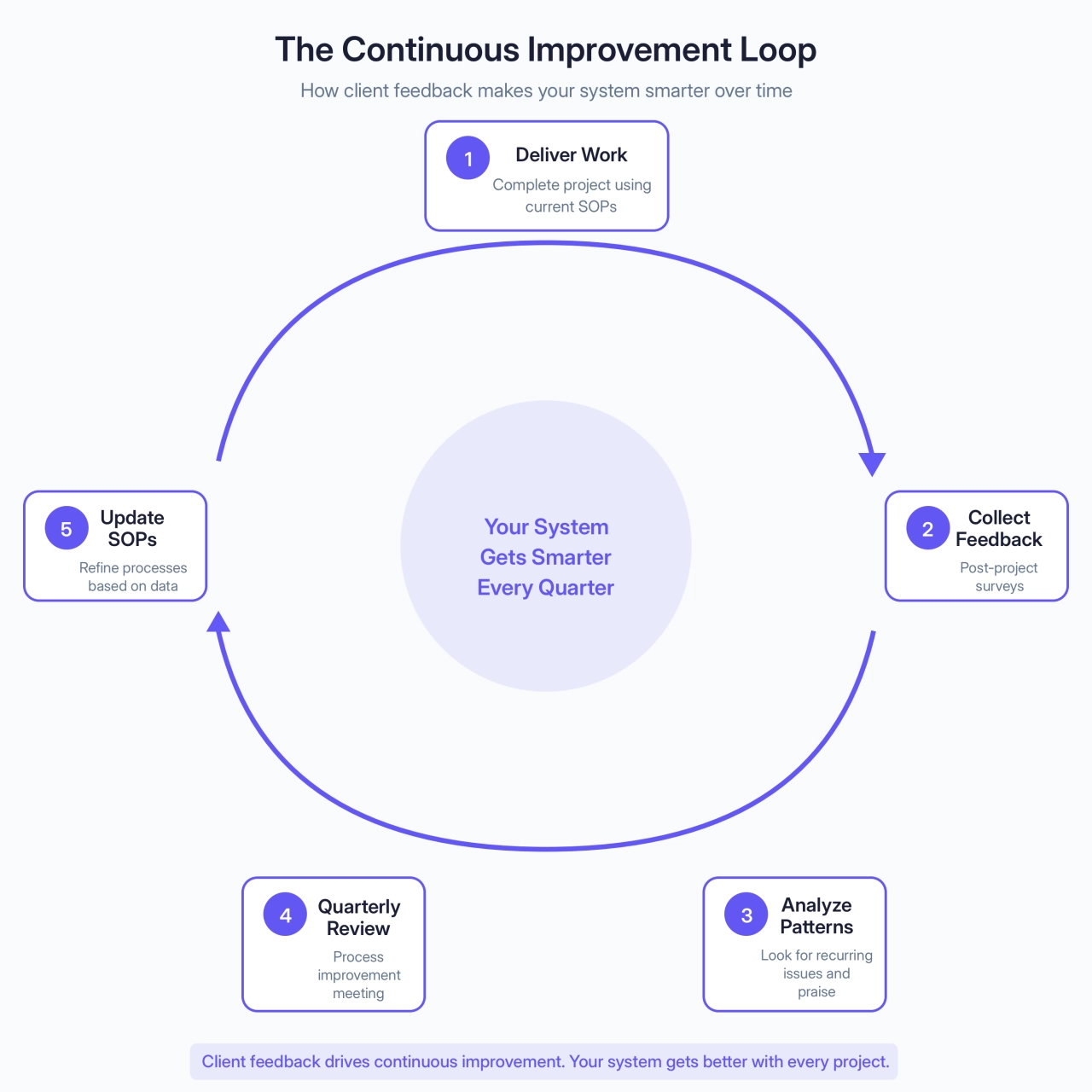
This feedback loop—from QC and clients back to SOPs and training—is what transforms your agency from a group of talented individuals into a team that consistently delivers excellent work.
The right tech stack to power your operations
While the strategy comes first, the right tools amplify your framework. They provide the infrastructure to make your systems easy to follow and manage.
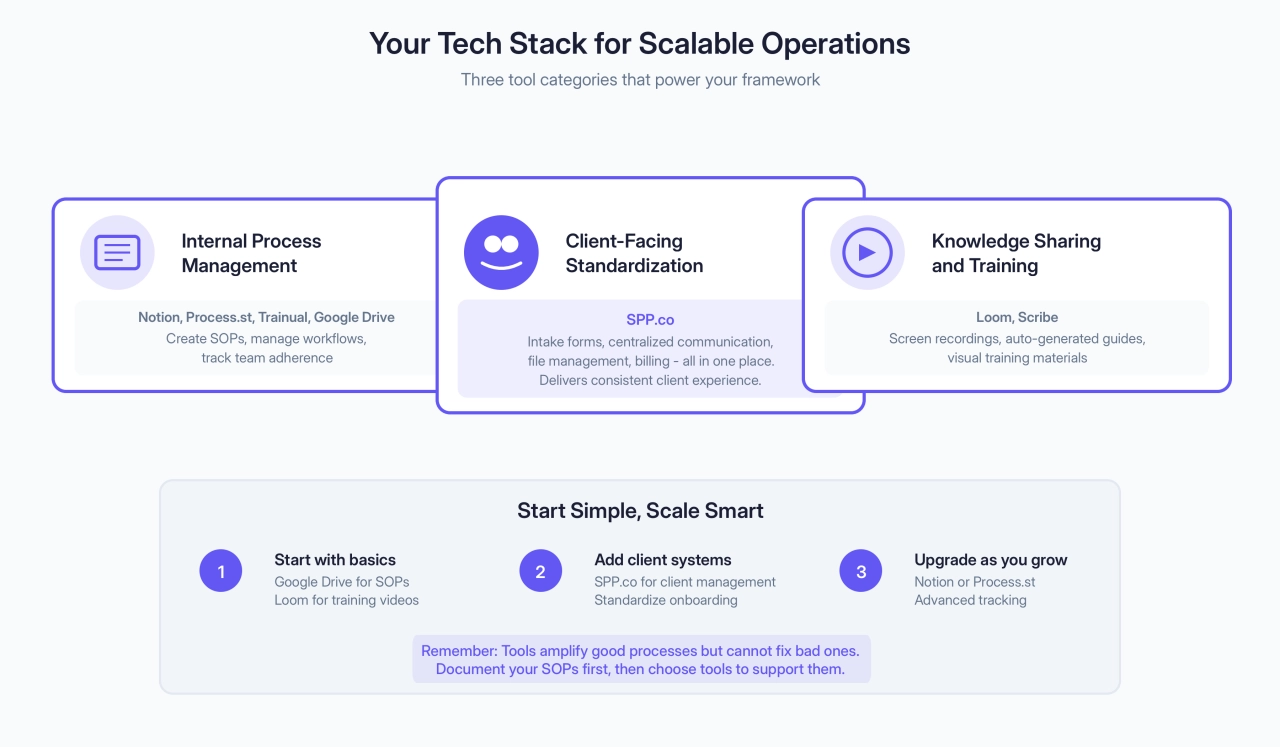
For internal process management & SOPs:
Notion: An all-in-one workspace where you can create rich SOPs, manage projects, and assign tasks.
Process.st / Trainual: Dedicated process management tools specifically built for creating checklists and tracking SOP adherence, which can be great for larger teams.
Google Drive/Docs: The simplest starting point. It’s free and easy, but can become disorganized as you scale.
For client-facing standardization:
SPP.co: Systemize everything from the moment a client lands on your website. You can create structured intake forms that ensure you get all the information you need upfront (a key part of your onboarding SOP). All communication, files, and billing are centralized, creating a single source of truth for every project and reducing chaotic email threads. It provides the rails for your team to deliver a consistent, professional client experience every time.
For knowledge sharing & training:
Loom/Scribe: Perfect for quickly creating screen-recording videos to embed in your SOPs. Scribe can even auto-generate step-by-step guides from a screen recording, saving you hours of documentation time.
Start with the basics—a simple project management tool and Loom for training videos. You can always upgrade to specialized software later, but you can’t upgrade away from poorly documented processes. With your tools in place, let’s address the questions that come up when agencies actually start implementing this framework.
Frequently asked questions
How do these three pillars work together in practice?
Think of it as a continuous loop: your SOPs define the standard, training ensures your team can execute it, and quality control verifies the output. The key is the feedback: when QC catches an issue, you determine if it’s an SOP clarity problem, a training gap, or if the standard itself needs adjustment. Each pillar informs and improves the others.
When should I start implementing this framework—before or after I hit scaling problems?
Start before the pain becomes unbearable. If you’re reviewing every deliverable yourself, you’re already too late—you’re the bottleneck. The ideal time is when you hire your second or third team member. That’s when inconsistency starts creeping in, and it’s much easier to build systems proactively than to fix quality issues retroactively.
Which pillar should I focus on first if I’m starting from scratch?
Standardization. You can’t train people on processes that don’t exist, and you can’t do quality control without defined standards to check against. Start by documenting your single most critical process—usually core task execution. Get that SOP working, then layer in training and QC. Don’t try to build all three pillars simultaneously.
How do I balance standardization with the flexibility productized services need?
Document the framework, not every variation. Your SOP should define the process and decision points—not dictate every outcome. For example, your content writing SOP might standardize research methods, revision rounds, and delivery format, while allowing writers to adjust tone and style based on client brand guidelines. Standardize the how, allow flexibility in the what.
What if my existing clients resist moving to a more standardized process?
Don’t force it overnight. Grandfather in legacy clients on their current workflow if necessary, but apply the new framework to all new clients starting immediately. Many agencies run a “classic” and “productized” version of their service simultaneously during the transition. Your goal is to prove the new system works, then migrate existing clients gradually as you demonstrate the benefits.
How long does it take to see results from implementing this framework?
You’ll see immediate wins (fewer mistakes, less time firefighting) within 2-4 weeks of implementing your first SOPs. Meaningful business impact—higher client satisfaction, faster team ramp-up, improved margins—typically shows up in 3-6 months. The framework compounds over time: each quarter’s process improvements build on the last.
How do I know if my quality control is too strict or too lenient?
Track two metrics: client revision requests and internal revision rounds. If clients frequently request changes that should have been caught internally, your QC is too lenient. If your team is doing 3-4 internal review rounds for simple deliverables, you’re over-checking. The sweet spot is one thorough internal review that catches 95% of issues before client delivery.
Can I implement this framework with a small team (3–5 people), or is it only for larger agencies?
Small teams benefit the most. With 3-5 people, you can implement the entire framework in a few weeks and immediately feel the impact. Larger agencies face more change management challenges. Start with your five must-have SOPs, create simple checklists for QC, and use your existing team meetings for training. You don’t need complex software or processes—just clarity and consistency.
What if I start this and it fails halfway through? Won’t I waste time and create more chaos?
Start with one process and test it over 2-3 projects. If it doesn’t work after 3 weeks, you’ve invested 6-8 hours—minimal risk. In reality, teams typically embrace clear standards because they eliminate guesswork and reduce client revisions. The first successful SOP motivates you to document the next. Small wins compound, and staying in the scaling trap costs far more than trying and adjusting.
My team is already resistant to change. How do I get buy-in?
Frame SOPs as solving their pain: “You’ve mentioned unclear expectations and last-minute revisions. I’m documenting our best practices so everyone knows what great looks like.” Involve team members in creating SOPs—people support what they help build. Start with your most influential team member as a champion. Once they experience fewer revisions and less confusion, they’ll advocate for the system and others will follow.
Conclusion: move from founder-reliant to system-reliant
Building a scalable service business is less about finding new growth hacks and more about a commitment to operational excellence. It’s about building a system that can deliver quality without your constant, hands-on intervention.
The framework is simple:
Standardize your processes with clear, actionable SOPs.
Train your team systematically so the SOPs become second nature.
Control quality rigorously to ensure standards are met and to fuel a loop of continuous improvement.
This journey transforms your role from the company’s primary doer to its primary designer. You stop being the firefighter and become the architect of a system that creates value, satisfies clients, and empowers your team to do their best work.
Here’s what this looks like six months from now: You’re not reviewing every deliverable at midnight. Your team handles client work confidently without asking “Is this right?” three times a day. You hire someone new, and they’re productive within two weeks instead of two months. A client emails specifically praising your team’s consistency. You realize you took a full day off without checking Slack once.
That’s not a fantasy—that’s what happens when you build systems that work without you.
Don’t try to boil the ocean. Start small. Pick one frustrating, inconsistent process this week. Document it, create a simple checklist, and have your team use it. That small step is the beginning of building a business that can truly scale beyond you. If you need help with the first steps, see our full guide on how to productize a service.






